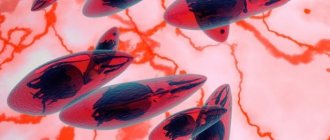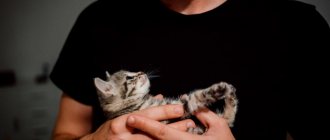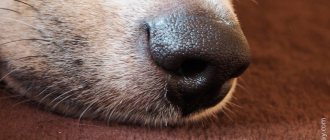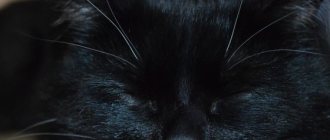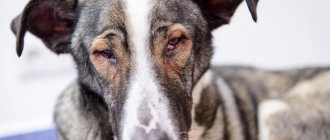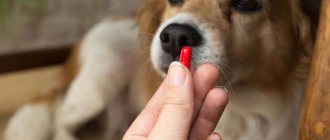Who are lice and what do they look like?
Let's figure out who lice are and what they look like. Lice are external parasites that live on warm-blooded animals, humans and plants. Lice infestation is commonly called pediculosis.
Depending on the variety, lice can feed on blood, skin cells (both living and dead), lymph, skin secretions, and plant juices. Unfortunately, numerous and prolonged infestations can cause serious illness and death, especially among puppies.
Note! The appearance of lice depends on their variety.
Types of lice in dogs
There are two types of lice in dogs, which are divided into subspecies:
- The first species is the numerous subfamily Mallophaga. This species parasitizes birds and mammals and can feed on blood, skin and skin secretions.
- The second species is the subfamily Anoplura . These parasites “hunt” only on warm-blooded mammals and feed exclusively on blood.
Lice are species specific, meaning they are not transmitted from one host species to another. Transmission can occur, but a parasite that ends up on a host of another species cannot reproduce. Dogs are typically infested with two types of lice.
Note! To determine the type of lice on a dog, it is necessary to examine the parasite under a microscope. Visually, external differences between lice of similar varieties cannot be detected.
Dog louse (linognathus setosus)
The dog louse (linognathus setosus) is a parasite that feeds exclusively on blood. The mouthparts of these lice are narrow and sucking. In addition, parasites have very tenacious paws with hooks that allow them to stay on the fur.
An adult grows (in length) up to 1.5–2.5 mm. Females are larger than males. Typically, parasites accumulate on delicate areas of the skin - around the eyes, ears, neck and chest.
Note! Dog lice are found throughout the world. In cold climates, parasites survive on long-haired hosts.
Canine lice eater (trichodectes canis)
The dog lice eater (trichodectes canis) is a subspecies of lice that feeds not on blood, but on skin cells. Unlike dog lice, lice lice have chewing mouthparts. In theory, lice eaters feed only on dead cells, but when their population becomes critical, they do not disdain living tissue.
Lice eaters are widespread throughout the world. Prolonged invasion has a detrimental effect on skin health, causing intoxication and failure of internal organs. Diagnosis is difficult, since even adult lice eaters are almost impossible to detect without optics.
Important! Lice eaters are carriers of the tapeworm Dipylidum caninum (cucumber tapeworm).
What do lice look like on a dog?
The parasites that live on the body of dogs are yellow-gray in color and small in size, ranging from 0.4-0.6 mm. The insect has an oblong body with a large abdominal region, a small chest and a head, on which two simple eyes in the form of pigment spots may be present. In some parasites, the organs of vision may be completely absent, and orientation in space occurs thanks to special villi on the body, which act as organs of touch. All types of lice have a piercing-sucking type of mouthparts.
The lips form a retractable proboscis with two stiletto jaws that easily pierce the skin of the animal. The end of the proboscis is crowned with special securing hooks, ensuring reliable adhesion of the parasite to the victim during the blood sucking process. Adults move easily in animal fur, helped by hook-shaped ends on their legs.
Lice eaters are frequent neighbors on a pet's body. Insects belong to the same order as lice and have a similar structure. The only difference is that parasites feed on fluff and dead scales of the dog’s skin.
Other types of lice
All other types of lice also belong to the species of ectoparasites (external parasites) and the order of lice. Depending on the type of parasitism, the louse's mouthparts can pierce the skin and suck out blood, or separate tissue scales.
Despite their widespread prevalence, lice are quite picky about their living conditions. To prevent the reproduction chain from being interrupted, parasites must live at a certain temperature and humidity.
Note! There are more than 500 species of lice in the world, but they are all host-specific, that is, they parasitize certain mammals or birds.
Moose lice
Moose lice (deer bloodsuckers, moose flies, moose ticks) are parasites that look more like small flies. Typically, bloodsuckers parasitize large mammals (deer, elk, roe deer).
With a sharp increase in the number of parasites, they can attack wild boars, foxes, bears, dogs, goats and even birds. With a lack of nutrition, bloodsuckers attack people. The parasite can only reproduce on a specific host. Eggs are laid only by adults, which (usually) have wings and grow to 3–3.5 mm.
Chicken lice
Chicken lice are a dangerous parasite and carrier of infectious diseases in birds. In cities, they parasitize chickens, especially broilers. It is difficult to detect the parasite visually; the length of an adult individual reaches 1.5–2.5 mm. The color of the shell is brown. Chicken lice do not parasitize dogs.
Cootie
The body louse is a type of human lice. The name comes from the word "dress". Parasites were widespread until the 18th century. This parasite can only feed on human blood, but does not live on the body permanently. Having had enough, they hide in the folds of clothing and bed linen.
grass louse
Herbal louse (plant louse) – unlike its “relatives”, has wings. It parasitizes only plants, feeding on their juices. Another name is plant aphids.
White louse
White louse (egg) is the result of reproduction of sexually mature females. The lifespan of a female louse reaches 38–40 days. During her life, the female lays up to 200 eggs. To keep the eggs safe, the female glues them to wool or fabric using special, viscous secretions.
This is interesting! After hatching, the larva can go without food for some time or feed on the remains of the vital activity of adults.
Black lice
Black lice are parasites that live on the human scalp and feed on blood. They cannot live on areas of the skin that are not covered with hair. This type of lice does not parasitize dogs.
How to distinguish dog lice from fleas, ticks and ticks
When diagnosing, it is important to accurately determine the type of ectoparasite. Let's figure out how to distinguish dog lice from fleas, forest ticks and subcutaneous ticks.
Lice and fleas are wingless insects:
- Lice belong to the order of lice. Lice are divided into two types - some feed on blood, others on skin and tissue cells. In addition, there are lice that feed only on dead cells and do not harm the host (they exist in symbiosis). Lice do not jump and move more slowly than fleas. The structure of the body helps it not to leave the carrier throughout its entire life. Lice have thick, powerful legs with claws (hooks) with which they hold onto hair or feathers.
- Fleas are parasites that feed on the blood of mammals and birds. Fleas have an oblong, oval, streamlined body. Due to this structure, fleas move quickly. They have long legs, and the hind pair (responsible for pushing power) is especially well developed. It is believed that the length of a flea's jump exceeds the length of its body by 130 times. Fleas often jump off the animal after feeding.
- The forest tick (ixodid or meadow tick) belongs to the arachnid family. Like a spider, a tick has eight prehensile legs and moves sideways very quickly. Females are larger than males. Only females bite; males are needed only for procreation. The size of an adult female in a state of hunger reaches 3.8–4.2 mm, after saturation - up to 1 cm.
- The subcutaneous mite is Demodex canis. The disease caused by subcutaneous mites is called demodicosis. Mites parasitize hair follicles, sebaceous glands of the skin, as well as internal organs. Demodicosis manifests itself in the form of severe dermatitis, hyperkeratosis, damage to internal organs and progressive exhaustion. Demodex canis is ubiquitous and lives on the skin of healthy animals. It is impossible to detect the parasite visually. The diagnosis is confirmed only in the laboratory. At the initial stage, the examination result may be false negative.
Important! Unlike fleas and lice, ixodid ticks are carriers of dangerous viral diseases - piroplasmosis, Lyme disease, encephalitis.
Symptoms and danger of infection
It is quite difficult to recognize an infection at the initial stage. When a dog lives outside in an enclosure and the owner rarely observes the pet’s behavior, the number of insects increases rapidly. Typically, infestations with lice and lice eaters are reported:
- severe scratching of the skin until it bleeds;
- matted fur in representatives of long-haired breeds;
- the appearance of light dots against the background of dark fur.
Infection of dogs with lice is called siphunculatosis. If you do not treat the animal in a timely manner, an increase in the number of parasites will lead to consequences such as:
- hair loss and bald spots;
- exhaustion of the animal;
- helminthiases;
- anemia with severe infection.
If you notice small bites on your body, then it will be useful for you to know how to treat your apartment for fleas. Acaricides will save your plants from mites and breathe new life into them. You will find examples of drugs in this article.
Looking for an effective flea treatment for cats? Then the article at the link will be useful to you.
Transmission routes
There are clichés that only dirty dogs get lice and fleas. In fact, absolutely all animals are at risk. In addition to lice, when returning from a walk, a dog can bring fleas and ticks into the house.
How a dog can become infected and how lice reproduce
Let's look at how a dog can become infected and how lice reproduce. Lice are transmitted from one host to another through close contact. For the most part, this means that an uninfected dog must be in direct contact with a carrier. Infection can occur through sharing brushes, resting places, towels, overalls, and collars.
The louse moves by crawling and cannot jump or fly. In rare cases, a dog can become infected with lice without direct contact with the host. Without food, provided the weather conditions are tolerable, lice can survive without a host for up to 24 hours.
The risk of infection increases if the dog is in close contact with stray or foreign animals. Risk areas include walking areas, nurseries, open-air cages, grooming salons, pet stores, and shelters.
Lice reproduce by laying eggs. Visually, lice eggs are white and translucent. They look like grains of semolina porridge. When crushed, a characteristic click is heard. The egg must be in a favorable environment throughout the entire gestation period. In the first 8 days, the temperature should not be lower than 36 degrees. In the next 16 days, the egg will not die if it ripens at temperatures up to 22–40 degrees.
Can a dog get infected with human lice?
Can a dog get infected with human lice? Lice are species-specific parasites and do not feed on the blood or skin of mammals of other species. Dogs cannot get lice from their owner.
Are lice transmitted from dogs to humans?
The species of lice that live on dogs can bite people, but cannot reproduce on the human body. Therefore, lice cannot be transmitted from dog to person. If parasites appeared on you and your pet at the same time, this is a coincidence.
People become infected with lice from other people or through shared objects (clothing, combs, hats, pillows).
Signs and symptoms of lice in dogs
Signs and symptoms of lice in dogs increase as the infestation population increases. An infected dog may exhibit one or more of the following symptoms:
- Severe wandering itching.
- Scratching and weeping wounds on the skin.
- Desire to rub against furniture, ride on your back.
- Biting wool.
- Excitement.
- Lack of long, deep sleep.
- Dermatitis.
- Extensive skin irritation.
- Signs of allergies.
- Loss of coat shine.
- Disheveled, overdried, split ends.
- Hair loss - most often affects the head, neck, area around the ears, at the base of the tail and anus, and in the groin.
- Anemia and loss of strength.
- Weight loss on the background of the usual diet.
- Lethargy.
- Developmental delays occur in puppies.
The above symptoms may indicate an infestation with dog lice and lice. An accurate diagnosis can only be made after determining the type of parasite.
The danger of lice and lice for cats and dogs
Lice and lice-eaters themselves are not very dangerous, but the consequences of their parasitism can be very serious.
- Cucumber tapeworm infection
. Like fleas, cat and dog lice eaters are intermediate hosts of tapeworms. An animal becomes ill by swallowing an infected insect while biting it. Young children who are in close contact with pets can become infected with cucumber tapeworm. - Severe exhaustion
. Due to itching, animals cannot rest and eat normally and become nervous. Puppies and kittens become weaker, lose weight, and lag behind in growth and development. Infected dogs may experience anemia due to the high number of bites. - Secondary skin problems
. Inflammation of the skin and self-injury during scratching cause secondary pyoderma (reproduction of pyogenic microflora). A complex of allergic reactions to parasite bites leads to severe dermatoses. - Infectious diseases.
There are few of them, they are rare, but they are especially dangerous (for example, tularemia).
Diseases caused by lice
It is important to remember that diseases caused by lice often develop covertly and are discovered when serious damage has been caused to the body. In most cases, dogs react violently to the discomfort associated with movement and lice bites, but asymptomatic infestations can also occur.
Note! Lice do not transmit viral diseases in dogs.
With the classic development of infestations, scratches and wounds become secondarily infected, which leads to inflammatory processes. Because treating inflammation without eliminating the cause is useless.
Liceworms, like fleas, are carriers of borage - an insidious, flatworm that can parasitize for years. Primary infection occurs when the host ectoparasite is ingested. The worm attaches itself to the intestines and poisons the body with waste products. The eggs of the parasite are released into the external environment with feces, after which the dog may be re-infected. All domestic animals, including cats, can become infected with oregano.
This is interesting! Human lice, at one time, often became the cause of typhoid epidemics.
Pediculosis in dogs and other animals
General information.
Pediculosis is a disease whose main symptom is severe itching of the skin caused by lice.
As you can see in the photo, lice in dogs and other animals live on the skin and fur:
Clinical manifestations.
With head lice, the animal begins to behave restlessly and loses its appetite completely. This happens due to severe itching. Lice can be seen through a magnifying glass and under a microscope. Lice testicles are pear-shaped and stick to individual hairs. Infection most often occurs through contact with another infected animal.
Treatment and prevention.
To combat lice in dogs and other animals at home, treat the animal's fur with contact insecticides. To do this, the animal must be bathed 2 times a day in a 0.5% bromocyclene solution. The course of treatment is 7-10 days.
When a diagnosis of lice is made in at least one individual, all animals kept together must be subjected to appropriate treatment. Pet habitats should also be treated.
Treating a dog at home
You can treat your dog for lice at home. It’s easy to remove parasites; the main thing is to systematically approach the problem. If an infestation is discovered at a veterinary clinic, the doctor will help you choose the best treatment option. If the diagnosis was made independently, it is important not only to cure the pet, but also to secure the home.
A one-time treatment of the animal and home may not be enough. If the infestation lasts more than 2-3 weeks, there are already lice eggs in your home, on your dog's belongings, furniture, and flooring. The eggs will become larvae within 1-2 weeks and a new wave of infestation will begin.
Lice eggs are not harmed by common remedies for ectoparasites, so when treating a dog, you need to use drugs that last at least 4 weeks. Indoors, eggs can only be destroyed using high temperatures (above 40 degrees) or poisons that have a prolonged effect.
Shampoos for lice, fleas, ticks and hairworms
For treatment, you can use shampoos against lice, fleas, ticks and lice eaters:
- Beaphar.
- Biofan Zoo.
- Rolf Club.
- Mr Bruno.
- Leopard.
- Lugovoy.
- Phytoelite.
- Dana.
- Celandine.
- Doctor Zoo.
- BioVax.
Shampoos are used according to instructions. Insecticides contained in shampoos stay on the coat for up to 3-7 days. The advantage of shampoo is that it is safe, unlike drops.
Drops on the withers for lice
The most effective remedy for treating ectoparasites is drops. Popular drops on the withers against lice:
- Advantix.
- Advocate.
- FrontLine Combo.
- Beaphar.
- Rolf Club 3D.
- Prac-tic.
- Prazicide Koplex.
- FiproGuard.
- Gamma.
- Dironet.
- Insectal.
- Leopard.
- Celandine.
- Dana.
- BlochNet.
- Fiprist.
- Palladium.
When treating lice, a one-time treatment is sufficient. To prevent infection, treatment is repeated every 1–3 months.
Lice collars
Lice collars are used as a means of prolonging the effect of drops or shampoo. Popular anti-parasitic collars:
- Foresto.
- Beaphar.
- Kiltix.
- Inspector.
- Gamma.
- Bolfo.
- RolfClub 3D
- Sentry Pro.
- Effectvet.
- Leopard.
- Dana.
- Celandine.
- In-Up.
- Mascot.
- Mr. Bruno.
When using a collar, you need to take into account the operating features. For example, many collars lose their protective properties after getting wet or are only effective for 2-3 weeks.
Combing combs
If you want to speed up your dog's recovery process, you need to not only eliminate the adults, but also comb out as many eggs as possible from the fur. Combing combs will help you cope with eggs:
- Trixie.
- Safari Flea Comb.
- NitFree.
- IPTS
You can use regular fine-toothed combs for combing, but it is better if they are metal. It is better not to comb the coat immediately after bathing; wait until it is completely dry.
How to get rid of lice using folk remedies
What to do if anti-parasite medications are contraindicated for your dog or you are concerned about its health. To do this, you can use folk remedies.
If a dog has an undercoat, then it is almost impossible to remove lice without special means. Hundreds of eggs will remain in the undercoat, from which hundreds of young parasites will hatch. In addition, it is very difficult to thoroughly brush a long-haired dog. Grooming of the dog is permitted as a “last resort”.
Tip: Pay special attention to brushing the head, neck, groin area and tail.
All lice that you manage to catch should be placed in a closed container with water. After combing out, eggs and adult parasites must be killed by heating. It is also worth boiling the comb.
To remove lice, you should use:
- Tea tree essential oil – has antibacterial and antiparasitic properties, relieves inflammation, prevents re-infection. To carry out the treatment, add 5 drops of oil to a small amount of shampoo and bathe the dog.
- Citronella oil is an excellent repellent. The oil is diluted in water and applied to the wool with a comb. As an alternative, you can use a water infusion of citronella.
- Lavender essential oil – has antiseptic properties and can be applied to the skin (if there are no open wounds). Apply 5 drops of oil to a cotton sponge, then wipe the irritated areas of the skin. You can add 5-7 drops of oil to shampoo and bathe your dog.
- Garlic – Considered toxic to dogs, but is often used to eliminate parasites. For a large dog, add 1 small clove of garlic to the food, for a small dog - ½ clove. Thanks to garlic, the smell of skin secretions becomes unbearable for parasites.
Wormwood is considered the most reliable folk remedy. This is a medicinal plant containing essential oils that effectively eliminate lice and fleas. From wormwood you can prepare a decoction and infusion, which is used to treat the dog’s fur and skin (bathing, combing). Dry grass can be placed under carpeting and behind furniture to speed up the removal of pests from your home.
Prevention measures
Prevention measures require an integrated approach to the disinfection of animals and homes. It is important to remember that adult lice become more resilient in cold temperatures. At temperatures of 10–20 degrees, lice can survive without food for 7–10 days. The temperature in the home must be higher than 20 degrees, otherwise some disinfection measures will be ineffective.
Important! If one pet is infected with lice, you need to treat all animals in the house.
After removing lice from a dog, quarantine is required for 4-6 weeks. At this time, it is necessary to carry out wet cleaning and, if possible, treat the home with steam. All dog accessories must be disinfected at high temperatures (washing, ironing, direct sunlight).
Treatment methods
Removing lice from a dog is easier than detecting them. Any insecticidal preparations that are relevant in the fight against fleas or bedbugs are suitable for this.
Unlike bedbugs and fleas, lice cannot leave their prey, so they will die under the influence of potent substances in insecticides.
Suitable for treating dogs:
- Drops on the withers. Choose only medications that are suitable for your pet of your breed and age. The drug is dripped onto the withers. The insecticide enters the bloodstream and poisons the lice. Suitable if they do not cause allergies in your pet.
- Sprays. Their advantage is the speed of impact. Most medications from different brands can be used on puppies. When used correctly, sprays do not cause allergies.
- Anti-flea collar. Helps at an early stage and at the same time protects the animal. Can be used as a prophylactic against lice and other parasites.
- Shampoos. Simply apply, leave for up to 20 minutes and wash off. It is important to apply the foam to the entire coat of your pet. They are more suitable for removing fleas from small breed dogs, since treating an infected dog will be much more difficult and financially expensive. Bathing is a routine routine that most dogs enjoy. This means that they will tolerate lice baiting easily and will not feel discomfort.
Pregnant and lactating dogs and sick animals require special attention. In this case, you should choose a method of insect control with extreme caution, carefully studying the instructions.

